Celia Lake's Blog, page 11
July 14, 2022
A little bit more… (topics and magic in Albion)
Today in our ongoing tour of the authorial wiki, a bit about some other topics. Today, we’re taking a look at the topical pages, which come in two groups, Magic and Topics.
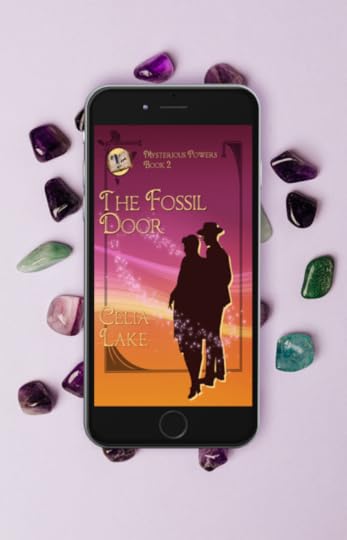 Magic
MagicI have lots to say about magic in Albion. (Unsurprisingly!) But I also wanted to make it easier for people to find more about particular aspects of it. Each section has a sidebar that makes it easy to go to other articles in the section, as well as links to other pages as relevant.
Some of what’s here has been explicitly explained in the books so far, and some of it hasn’t.
Magic in generalThe main section about magic covers general background. This includes:
An overview (linking to other pages) The Pact and the Silence . Includes some notes on how that works outside of Albion. Applications of magic . Ways magic can be used, with comments on tools like working stones, wands, Pleasing Tokens, and Words of Command. Magical capacity . See the note below. Land magic Portals and journals .On magical capacity, one of the things I thought about a lot when working out some details for Albion has to do with the question of how many people have comparatively strong magic, and what the difference is between being inherently powerful and having the training to use your magic most effectively. This obviously varies by profession (the Penelopes, higher ranks of the Guard, the Council, and some magical specialties obviously require substantially powerful magic, as well as training.)
But I also wanted a world where small amounts of magic could make a meaningful difference in someone’s life. For about half the population, what they have is more on the level of keeping the milk sweet longer, avoiding infections, reducing the threat from illness, or using magical tools (like keep-cool boxes and stoves) created by someone else.
In other cases, there’s magic underlying the infrastructure (heating, indoor plumbing, safer furnaces on ocean liners), but it’s not terribly visible to most people on the average day. Check the article out for some specific character examples.
The magical worldHere we have articles talking about Albion as a culture and community.
Magical creatures (fauna) and plants (flora) and other materials. Magical beings (The Belin, custos dragons, merfolk, naga, plant beings, and selkies. Basically any magical being who is visibly and obviously magical, rather than human shaped.) The Fatae and the Cousins Bohort and pavo , the magical sports of choice. Falconry Families , specifically the categories of family heritage relevant to Albion. Music (focused on the musical culture of Albion and the way magic and Albion’s history affect music.)I’m glad to add other topics – just let me know what you’re interested in seeing! I’m hoping to spend some time in the theatre community of Albion at some point, it just hasn’t come up much so far.
Magical skillsThe Magical Skills page links to all the different kinds of magic – Agricultural to Sympathetic. Each page includes a summary and information about the necessary education. I’ve also included examples (avoiding explicit spoilers) and notable experts, with links to the relevant pages.
The Duelling page has more details both about the different rule sets and the process for duelling.
TopicsOur last category of articles for today are topics – basically everything that isn’t specifically about magic.
Demographics for some numbers about the population of Albion. History , particularly how it diverges from our history. Education Government Judicial system Religion Gender and sexuality Magical community in the Great War includes examples of who did and did not serve. Non-magical community and the places that overlaps most noticeably. Titles and forms of address (including why the title for Lord and Lady doesn’t work quite the way it does in non-magical society.) Have other topics you’d like to see?Drop me a note in the contact form, or reply to any of my newsletter emails, and let me know! Questions are a great way for me to know what people are interested in hearing me natter on about a bit more.
The post A little bit more… (topics and magic in Albion) appeared first on Celia Lake.
July 7, 2022
People together (groups and organisations)
Welcome to the next stop on the tour of the authorial wiki. Last time we talked about characters, so now it’s time to take a look at groups and organisations.
GroupsThere are a number of common group connections in Albion – notably related to the Five Schools, but also secret societies and professions. Read more about the professional and social organisations in general over here.
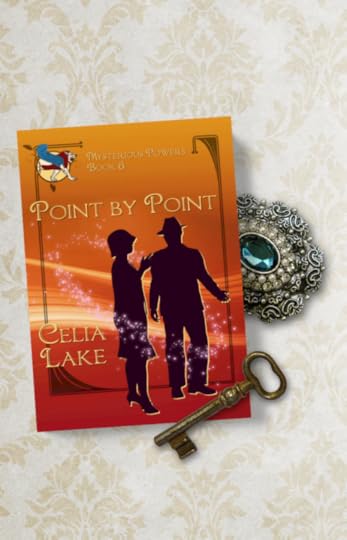 Point By Point shows what a group can do together.Professions
Point By Point shows what a group can do together.ProfessionsProfessions are one of the most obvious groups, of course. Each page includes information about the profession, including aspects of their training, notable members, and relevant quotes.
The professions include:
The Council The Guard Penelopes Healers Schola HousesOne key social group for anyone who went to Schola is their school house. Students are selected for these via a process known only to the teachers (discussed in part during Eclipse). And as discussed there, this is not a perfect system. Both Isembard and Alexander, for example, would likely have done much better in other houses, but Fox was and is seen as the most socially prominent and desirable.
These houses are not only where students live during their time at Schola, but each house also has specific magical techniques and approaches taught within the house. Owl House, for example, has its own set of charms and methods for taking notes and indexing them. Once students graduate, they continue the connections at the club associated with their particular house, on Club Row in Trellech.
You can read about each of the houses on its own page. The page includes a brief background, symbols, the heraldry, and a list of notable (aka point of view) characters from that house. It also notes the colour of stone (and a few examples) used in house pendants, rings, or other jewellery.
Bear House Boar House Fox House Horse House Owl House Seal House Salmon HouseAs a note, students at Alethorpe live in houses, but they’re arranged differently (via compatible groups of interests after the first two years). I hope to explore what it’s like at Dunwich, Forvie, and Snap at some point!
SocietiesAlbion has both very public social organisations and secret societies (both generally known and more private, such as in Magician’s Hoard and Point By Point.)
When it comes to secret societies, Schola has seven, with students selected by current members in their second year (so they are members for three full years before leaving school). Only a couple of these have had much mention in the books so far, but I’m expecting to spend more time with all of them in the future. The societies have a shared focus, and provide mutual support, training in specific kinds of magic, and connections that many of their members focus around for the rest of their lives.
Each page has a summary of the society, their stated and actual goals, and a list of notable members. I’ve included key quotes about the group as relevant.
Animus Mundi (ritual magic) Dius Fidius (protection of good faith in public affairs) Dwellers at the Forge (progressive Promethean bent, with the most time on the page so far) Four Metals (crafting) Many Are The Waters (healing and liminal spaces, with a sister group at Alethorpe) The Nine Muses (performing arts) Society of the White Horse (agricultural magics, horses, and liminal psychomps, also at Snap) Social clubsFinally, there are quite a few social clubs. Each of the Schola houses has their own, but there are also a number of others. They all have facilities for meals (a dining room and more private spaces), social gathering spots, a bar, ritual workrooms, and some spaces upstairs for people staying overnight.
(There are in fact relatively few inns or hotels in Trellech, because most people will stay at their club if they’re in town for a few nights and need somewhere.)
Each page talks about the membership requirements, their spaces, and notable members.
There will be more!I’m sure more groups and organisations will pop up over time. If there’s a group you’d like me to write up, just drop me a note with the contact form (or reply to any of my newsletter emails.)
The post People together (groups and organisations) appeared first on Celia Lake.
June 23, 2022
Character Connections
We’ve talked about extras, maps, and timelines in our tour of my authorial wiki. Now it’s time to talk about characters. Every point of view character has a page. (That means everyone who’s been the point of view in a novel, novella, or extra…)
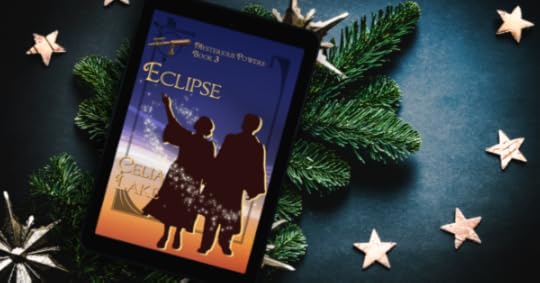 (Eclipse has my largest character list by far…)How to find character pages
(Eclipse has my largest character list by far…)How to find character pagesIf you’re looking for someone specific, just search on their name (first, last, both, whatever you prefer) in the search field at the top of the page. You’ll see a page come up with their name if they have one (as well as other pages where that name appears).
If you’d rather browse, start on the main index page. Click on “People” and then on whichever series you’re interested in. (Characters are grouped by series to keep the list length manageable.) You’ll also see three other pages of characters that I’ll talk about in a minute. Galen is listed under Mysterious Powers.
Character informationEach point of view character page includes:
A summary of their background up to their first chronological appearance in my books. For some characters, there’s more about their family or personal history. If particular books are relevant, I mention which ones.
Appears in gives a brief summary of which stories they appear in. These use a spoiler link, to avoid spoiling details of books you might not have read yet. Just click or tap on “learn more” for the details. These summaries are brief – my goal here is to help you remember which book covers what, not to recap all the details.
Then we have some sidebar content…An image of the character: First, if these don’t match your idea of what someone looks like, that’s fine! I worked off the description of the character in text, but the tool I’m using for these images has some limitations. (For one thing, glasses aren’t an option yet…)
The images come from an app (in the final beta stages as I write this) called Portrait Works that allows you to mix and match features, change colours, and layer clothing and items. As you can see if you look at the range of my characters, it has quite a lot of options!
If you’re inclined to fan art, I would love to talk to you more if you do any of my characters or places, and see about sharing it, too.
Books: Which books the character appears in (and their general role in each – main character, secondary character, a cameo, etc.)
Details: Some key biographical notes, including:
Year of birthFamily members or connectionsProfessionEducation (school, and when relevant, house)Other memberships of note (mostly secret societies.)I added these details under the assumption that “these two people who are the main characters in a romance end up together” is not a spoiler (and to make some navigation options easier between pages) but I’m open to alternative approaches here.
Lists of charactersTo help you out, I’ve also built three lists of recurring characters (who show up in more than one book), but who aren’t point of view characters.
This list has general recurring characters (who aren’t Council Members or Schola staff). Curious about a mention of someone? Searching on their name or checking this list should help. If someone’s not on here, let me know, and I’ll see about adding them.
(This list is long, and likely to continue getting longer, so I am thinking of ways to organise it better. If you have thoughts about what would make it more useful, I’m all ears. Having a single list does help with keeping it up to date.)
I have a complete list of the Council Members from before the Great War through the 1940s, but many of their names have not yet appeared in print. This list has everyone I’ve mentioned so far.
It also includes the date they challenged for their Council seat, a retirement or death date if relevant, and a brief background, including where they’re mentioned, their Schola house (at the point I’m writing this, all of them attended Schola), magical specialities, and other associations.
Here I’ve listed the core teaching staff, the subjects they teach, and their other duties (as well as when they started teaching.) As the top of the page notes, there are a number of other staff at Schola, who haven’t been named in text yet.
There’s a complete list of teachers during Eclipse, and then updates with the changes during Chasing Legends, and a note about former staff.
The post Character Connections appeared first on Celia Lake.
June 16, 2022
Maps: The place where it happens
Time for stop 3 on our tour of the authorial wiki, maps! Today we’re going to look at two sets of maps, one for Albion as a whole, and one for Trellech, the main magical city. My maps are by Michael MB, who did a fantastic job taking my sketches and making them usefully informative.
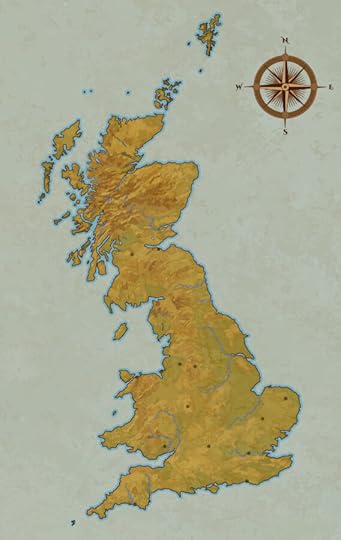 Albion
AlbionThe maps
Right now, there are two maps. One of the great tools in WorldAnvil is that I can put markers on the map that link to a page about that place. This may appear in a sidebar, or it may appear below the map, depending on what sort of device you’re using.
The locations of the markers are somewhat approximate, but should give you a general idea where things are located, what’s close by, and what’s further away.
Albion Albion
AlbionAlbion is basically Great Britain, which is to say, England, Wales, and Scotland. (Ireland is doing its own thing.) There are, however, things on the map of Albion that aren’t on our maps of Great Britain.
Most notably that island in Cardigan Bay, off the west coast of Wales. See the point of land sticking out at the bottom left? That’s Cornwall. Go up to the next bit sticking out to the west, that’s the bottom of Cardigan Bay. Schola – that island – is just above it.
The map also has a few subtle dots that indicate some locations (mostly cities) to help me locate places more easily. (And of course, some of those locations also are where specific stories take place.)
Explore the map of Albion. It includes markers for:
TrellechThe Five SchoolsLondonYtene and Veritas (the two landed estates where multiple books take place)And a few other spots of particular interest. Trellech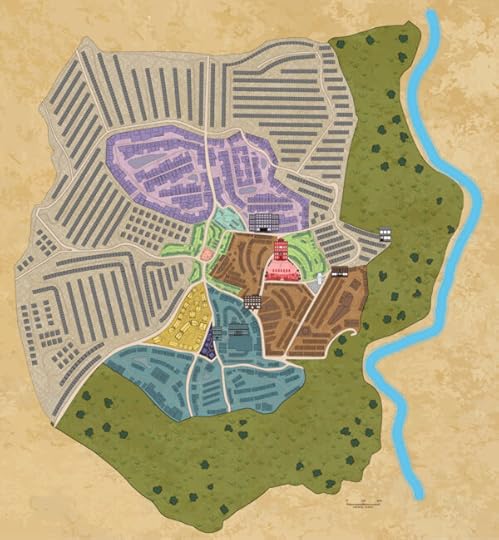 Trellech
TrellechTrellech presents a very different map challenge. While the magical Trellech is based on a real place (read about the history of Trellech), the current layout looks very little like the early medieaval layout other than the locations of some roads.
Explore the map of Trellech here. It includes:
Descriptions of the different areas of the city (colour coded on the map, and described in detail in the text of the Trellech page for people who prefer text description.) Residences (mixed and upper class)The Albion Museum (as seen in Pastiche ). Vivian Porter’s office ( Goblin Fruit and Fool’s Gold )The Scali bank and house ( Fool’s Gold )The Temple of Healing ( Carry On )Trellech Library ( Wards of the Roses )The Guard Hall ( Pastiche in particular)Club RowThe Ministry QuarterThe post Maps: The place where it happens appeared first on Celia Lake.
June 9, 2022
Timelines: Who, what and above all, when!
Welcome to the next stop on our tour of my authorial wiki (public version). Today, I want to talk about timelines and finding out when particular events happened.
 Eclipse is, of course, my book which is particularly anchored to a specific time and region.
Eclipse is, of course, my book which is particularly anchored to a specific time and region. One of the reasons I like WorldAnvil (the software I use for the public wiki) is the chance to create maps and timelines. With books ranging across the 1920s, a few Edwardian titles, and a couple during or just after the Great War, being able to put the books in order is key.
Albion – the main timelineThe Albion timeline is the first place to start if you want the chronological sequence of titles in a visual format, with links to the books and main characters in one tidy place.
It lists each book, in chronological order by when the book began. It also includes a few key historical events (the Pact, the Great War).
Each entry has:
The book cover (for an easy visual reference)Text and image links to the major characters. The main locationLinks to additional timelines. (Mostly the “Books and extras” timeline.)Note that I haven’t broken out the epilogues here, just to keep the number of entries more manageable.
Books and extras timelineLast week, I talked about the extras I’ve shared with my newsletter readers. Those often have scenes that take places at other points in the timeline, and I thought it would be helpful to see where those take place.
What if you want to know where those scenes fit in? That’s where the Books and Extras timeline comes in. Each of the scenes from the extras is there. (If there are multiple scenes in a short time frame, they’re grouped together.)
Again, you can get information on the extra (it will take you to the page with more information), the characters, or the location.
Character events timelineSometimes you just want to know when someone was born, or when they got married, or who might have been at Schola around the same time. (Just me on that one? Read on for how I handle that.)
The Character Events timeline is here for that. It includes birthdates for characters, a few marriages, and the dates various of the Council Members challenged for the Council. Dates are only on here if I’ve pinned down an actual date and mentioned it or strongly implied it in text.
(For example, I know when a number of characters got married, roughly, but I haven’t always decided on the actual date yet, just a period of a couple of months.)
Character’s years of birth are also on their individual pages.
Text versionWant something simple? Here’s a text timeline of the books (noting epilogue dates as relevant.)
Publication orderFinally, I know some people prefer to read in publication order. If that’s you, that list has you covered, and includes the extras as they were released.
Also good to know
Obviously, these timelines require a certain amount of upkeep. The front page of the wiki site will always have the most recent update (i.e. what the most recent book or extra I’ve added) and when that was.
Additional timelines I keepI of course have some more detailed timelines. I use an app called Aeon Timeline, that lets me link information in various ways, and also will tell me (if I have a person set up with a date or year of birth), how old they were during various events. This is, needless to say, tremendously helpful.
I – like a number of authors – spend a fair amount of time doing authorial math.
The most recent iteration of this, last night, was figuring out how old Silvia Warren actually was, which involved the following word problem: “If Claudio is in his third year (so around 15) in 1924-1925, and Silvia married and had him quite young, how old is she in a) 1932, b) 1941, and c) 1948?”
(If by this you guess I am contemplating writing something involving her more heavily, you’d be right. It won’t be for a bit, I have to write several other things to work out some details of what’s going into that.)
I track all sorts of other things:
Individuals (for birthdays, how old they are compared to other people ) Character events (marriages, deaths, key events in their lives)Education (when they were in school or apprenticing so I can see how that overlaps with others)Clubs and society eventsCouncil seat challenges (and other related dates) And of course, when the books and extras take place.They are all colour-coded and interlinked in the app, so I can make all those connections easier. I don’t want to make the wiki timelines too overwhelming, but if there’s information that would be helpful to you, just let me know!
The post Timelines: Who, what and above all, when! appeared first on Celia Lake.
June 2, 2022
Extras, get your extras!

What’s an extra?
Now and again, I write something extra. It can be a few thousand words, or thirty thousand.
It can be a bit of backstory I need to write out to keep going in the book. Or something that happens after the book ends that affects future events.
Sometimes, I just want to spend a little more time with those characters.
Other times, it’s a chance to get a bit of a story from someone else’s perspective.
I share these extras with my newsletter subscribers. And now I’ve got an easy way to let you know what extras there are (and what they cover).
Check out the Extras page on my authorial wiki for a short summary of each available extra. Click through on the title for each one to learn more about it. Scenes from the extras are also on my books and extras timeline.
Getting copies for yourselfIf you’re already getting my newsletter, starting on June 3rd, 2022, there’s a link at the top of every newsletter that will let you download whichever extras you like without putting in an email address.
If you’re not already on my newsletter list, you can get all the extras here. You’ll need to enter your email address for each one (or sign up for one, get the first newsletter email, and then use the link there to get the rest. Up to you!)
I hope you’ll stay around on my newsletter for news about what’s coming soon, more extras, and a few links and snippets of information from my writing that week. I send an email most Fridays. But if that’s not for you, it’s fine to subscribe and unsubscribe as you see fit.
The post Extras, get your extras! appeared first on Celia Lake.
May 26, 2022
Adventures in falconry
Last Saturday, I went on an adventure with Kiya, my long-time friend and editor. We drove out to western Massachusetts (about a two hour drive from where I live) for a session with New England Falconry.
Why? Writing research, of course!
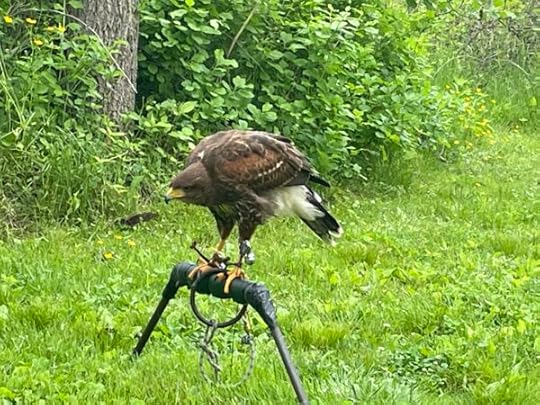 A Harris’s hawk on a perch, seeing something he’s not sure about. Falconry, Carillon, and upcoming delights
A Harris’s hawk on a perch, seeing something he’s not sure about. Falconry, Carillon, and upcoming delightsLord Geoffrey Carillon is a great many things, but among them, he is a falconer. As mentioned in On The Bias, he used to fly a Eurasian eagle-owl, named Theodora (who also appears in that book). However, the sniper wound he got during the Great War (in his left shoulder joint) means that he can’t hold that much weight on his extended left hand for very long.
(Eurasian eagle-owls are about 8 pounds for females. Extremely sizeable birds.)
Since the early 1920s, he’s instead flown a merlin named Helena. Merlins are a vastly smaller bird – about 8 ounces or half a pound. (They also carry a number of different social implications.)
Then I wrote the draft of Best Foot Forward (out in November 2022) and – there is more falconry. It’s set in 1935, when Carillon is fully settled into his current life, but collaboration with Alexander Landry brings about a new set of challenges. Alexander also has a certain number of opinions about hawks and falcons, as it turns out, though largely on a more metaphorical level. Or at least less immediately physical. There’s also a scene set in the mews at Ytene.
And then there’s Ancient Trust, which is about Carillon inheriting the title in 1922 and returning to Albion and figuring out how to rearrange his life. Which of course includes a certain amount of falconry, though mostly off-screen.
All of that meant more research about falconry was in order as both those titles go into editing. And of course, the one thing that’s hard to get from books or video or other second hand sources is what the experience actually feels like. I especially wanted to get a sense of what it felt like to have a bird on the end of my arm.
Which is why we went out to western Massachusetts.
Read on for more, including plenty of great pictures!
IntroductionWe began with Chris, the Master Falconer, introducing himself, and giving us about forty-five minutes of explanation about the birds, falconry, raptor biology and behaviours, and a great many fascinating related topics.
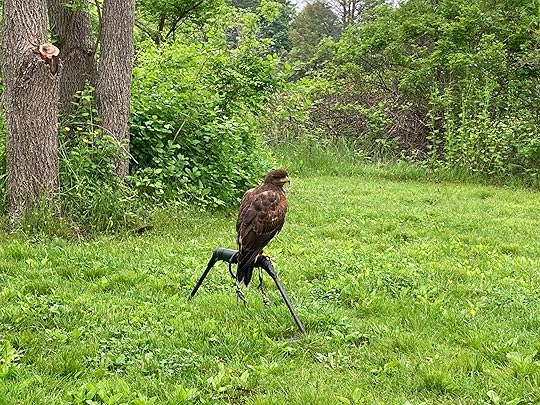 A Harris’s hawk on a ground perch, looking curiously around.
A Harris’s hawk on a ground perch, looking curiously around.During the lecture, there were two hawks on ground perches (with us on wood benches around them). These are both Harris’s Hawks, a species that isn’t indigenous to New England, or to Europe, but whose range is in South and Central America (these days extending up into Texas and New Mexico.)
They’ve become very popular with falconers, especially for demonstrations like this, because unlike most raptors, they stay in familial groups for their lifetime, and hunt collaboratively. This means they’re a lot more open to (and relaxed) about the idea of flying to a lot of different people in a day, so long as those people provide food. (Little bits of ground meat, in this case.)
They were remarkably relaxed while we did the talking parts of this, just looking around, occasionally making hopeful noises about food, or turning around on the perch.
These two are brothers (I didn’t get a shot of both of them together), both just about a year old. I didn’t get a precise weight on them, but likely somewhere in the 1 to 1.5 pound range. They’re attached to the perches with a rope that attaches with their jesses (the lines of leather from their feet), but they didn’t try to go anywhere at all.
Chris does not name his birds, and just refers to them as the last two numbers on their identification bands, in this case “60” and “61”. He pointed out that birds are really not like dogs or cats – they are in this for the easy predictable food, and forgetting that is hard both people and birds. On the other hand, it was entirely clear how much love and respect he had for them.
Experiencing a hawkThe real joy of this, though, was the chance to have them fly to us!
The sessions run with six people who get to experience falconry, and in our case, two observers. We each got the chance to have each bird fly to us twice, which was truly amazing. It was also fascinating to see the differences in the two in terms of personality. It also helped a little – just a little – with getting over the “There is a raptor right on my hand, wow!” moment and be able to pay attention to anything else.
The way this works is that you stand in a particular spot. The bird starts off on a tree branch nearby – maybe twenty feet. You put your left hand up, in the leather glove, and the bird flies to you. Or at least that’s the theory.
(That’s me, there, from the back. And 60.)
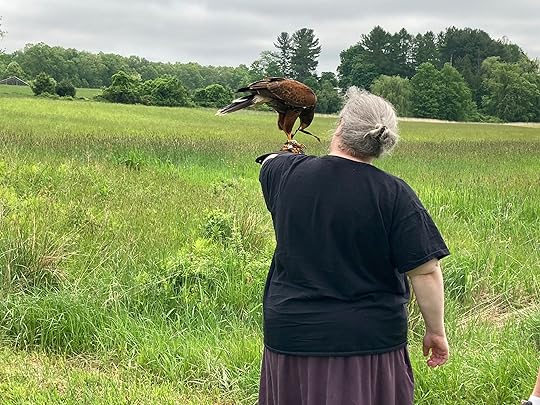 Harris’s Hawk, distracted by his jesses.
Harris’s Hawk, distracted by his jesses.Sometimes the hawk does other things. We had several rounds of the hawk flying from the starting tree to a much taller tree, and getting lured back to the original branch. We had a couple of rounds of the hawk spotting something interesting on the ground and hopping down. There was one bit where 61 was very fascinated by something in the field we couldn’t see. (There was also an overly curious redwing blackbird wandering around.)
The feeling of having the hawk land was amazing – they’re very tidy about it, they know exactly what they’re aiming for. (That’s the bit of meat just placed on your glove.) They hang out for thirty seconds, maybe a minute or so, and then go off again, because they know how the routine goes.
(This is how I could answer the necessary research question: my arm certainly wasn’t sore after four rounds, but I could definitely feel that I’d been holding it in a more complicated postion, with weight, by the fourth round. Holding a bird there, especially a larger one, for an extended period would be quite a lot.)
Kiya managed to get some fantastic photos, so here’s a sequence of one of the birds (I think this is 61), landing, and then taking off again. (That’s Chris, with me, supervising very carefully.)
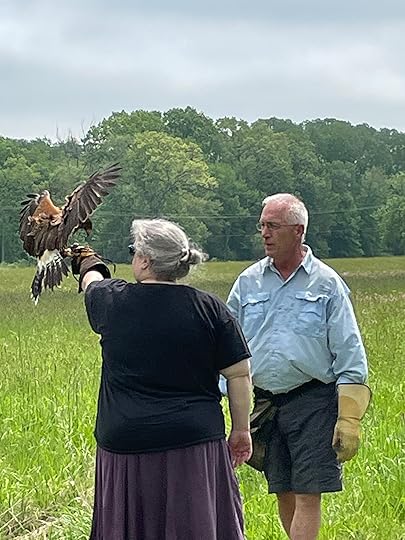 Harris’s Hawk landing on my gloved arm.
Harris’s Hawk landing on my gloved arm.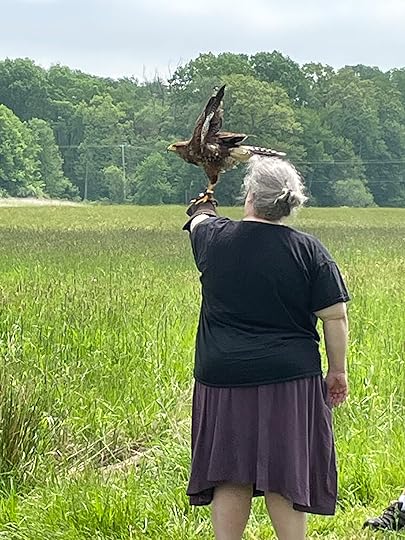 Hawk caught in the moment of taking off, wings up and back, body parallel to the ground.
Hawk caught in the moment of taking off, wings up and back, body parallel to the ground.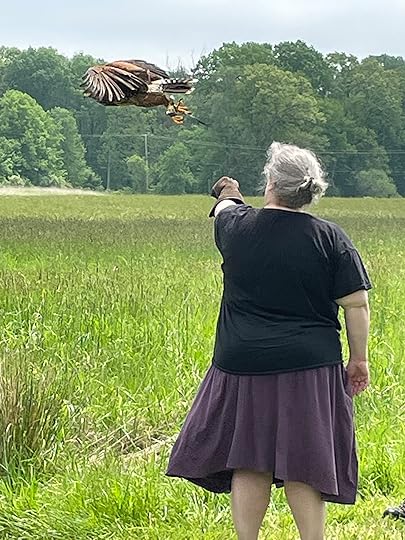 A moment later, the hawk is in the air, a foot or so away from my hand.Delight and enchantment
A moment later, the hawk is in the air, a foot or so away from my hand.Delight and enchantmentThe experience was absolutely fantastic. We’d been a little worried about the heat (it got up to over 90 in Boston and both Kiya and I are not designed for hot weather) but it didn’t warm up until we were done with the hawks and finding lunch before the drive back. I’m very excited for the ways this is going to help me make a couple of scenes more vivid, too.
If you’d like a bit more about historical falconry in the UK, English Heritage put up a fantastic 20 minute video with Raphael Historic Falconry, walking through falconry from the Romans to the Edwardians, complete with costumes and a wide range of birds.
(Also, if you’re in the New England area, drop me a note if you’d like more details about the logistics or anything of that nature. Or have other questions about this!)
The post Adventures in falconry appeared first on Celia Lake.
May 13, 2022
Point By Point is out!
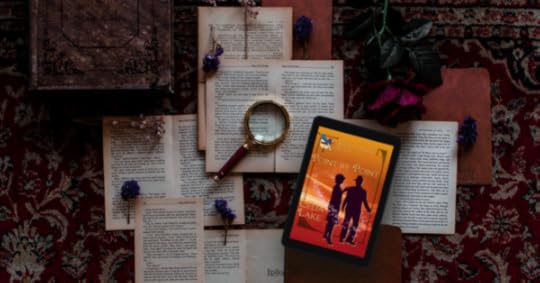
Welcome to Point By Point!
It’s a story of immersive journalism, 1920s style (with more than a bit of magic), old friends and new romances, with horse racing and two secret societies with very different goals in the mix.
Lydia’s been working as a journalist for years, but it’s past time make her name and get herself more steady assignments.
Galen – last seen in In The Cards – has been trying to sort his life out. His brother’s doing well and Galen’s been working hard and keeping very busy learning to turn the family import business around. But when Lydia asks for a favour, Galen finds himself saying yes.
Of course, Galen isn’t on his own. Martin and the other Dwellers at the Forge are intrigued by any project that might take down those reaching for power that isn’t theirs. Since Lydia’s interested in exploring what happened in the aftermath of Magician’s Hoard, they’re entirely eager to help.
Get your copy of Point By Point for a frolic full of racing, a house party, and more than a bit of ritual magic along with the romance.
(As with all my books, you can read this one without having read any of the others, though In The Cards introduces Galen, Martin, Julius, and Blythe, and takes place about a year earlier.)
The post Point By Point is out! appeared first on Celia Lake.
April 28, 2022
Question answered! Character ages
I got an email from a reader (hi!) asking a couple of questions, including this one: “In your romantic couples, the women seem to be consistently a little older (or a lot older) than the men. Was this a conscious choice, and if so, is there a reason for it?”
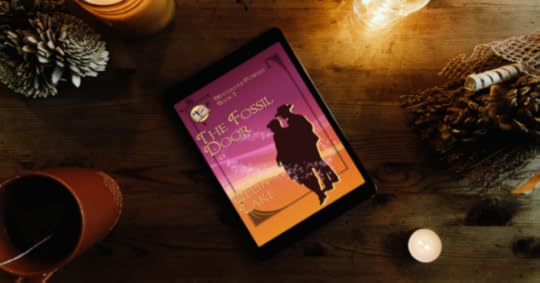 Keeping track of ages
Keeping track of agesThis is an interesting question – and a well-timed one, because I’ve been redoing my main timeline file to take advantage of some new features. I use an app called Aeon Timeline which is fabulous for this and other timeline purposes. My main file has entries for characters, their education years (so I can see who was at school with each other easily), book events, and of course some historical details and character background bits.
(I also have some secondary files, like one that tracks the specialities and precise dates for the Council members.)
One especially convenient feature is that once you set a birthdate (or year) for someone, it will then calculate their age compared to other events or people. I have events set for the beginning and end of the Great War, for example, so I can see how old people were at those points (and some set for the dates when the conscription ages changed, so I could see who was affected easily.)
This meant it was quite easy to go through and figure out the relevant character ages. I’m rounding to the nearest half year here, for ease of reading.
Characters so farOf the point of view characters in published books so far:
Ferry is 2 years older than Rufus ( Outcrossing )Geoffrey is 6 years older than Lizzie ( Goblin Fruit )Pross is 5 years older than Ibis ( Magician’s Hoard )Kate is 3.5 years older than Giles ( Wards of the Roses )Laura is nearly 8 years older than Martin ( In The Cards )Benton is 2 years older than Cassie ( On The Bias )Vivian is nearly 9 years older than Cadmus (but looks about that much younger) ( Seven Sisters )Richard is 5 years older than Alysoun ( Pastiche )Elen is 3 years older than Roland ( Carry On )Rathna is 7 years older than Gabe ( The Fossil Door )Isembard is 3 years older than Thesan ( Eclipse )Rhoe is 4 years older than Hugh ( Sailor’s Jewel )Mason is 1.5 years older than Rosemary ( Complementary )Robin is 4 years older than Beatrice (but looks about that much younger) ( Fool’s Gold )Seth and Golshan are about a year older than Dilly (they’re a month apart) ( Casting Nasturtiums )Mabyn is 2 years older than Cyrus. ( The Hare and the Oak )(And the one I’m writing now, Arthur is 3 years older than Melusina)So, that’s 16 m/f couples: 9 of whom, the woman is older. (And for those curious about Magni and Gil, Magni’s 3 years older.)
Age and characterI tend to think about characters fairly organically. At this point, in most books at least one character has appeared somewhere previously. So I start by thinking about who would be an interesting partner for them and also have an interesting story potential for how they get together.
Age is part of that dynamic, but it’s certainly not the only one. I think about profession and how they think and feel and are shaped by that profession. I think about their education (especially their House at Schola, which tends to shape people in particular ways). Sometimes it’s about who they apprenticed with, or experiences they had while establishing themselves as adults.
Overall, there are a couple of key considerations:
The WarHistorically, there’s the consideration of the women of the Lost Generation. Due to the deaths and injuries in the Great War, there are fewer men who are able to (or wish to) marry who are in their 20s or 30s in the 1920s. Gabe, Galen, and Martin are at the head of the generation who weren’t of age to fight.
That means that women in this age group are proportionately more likely to have a partner who doesn’t match them in age. This is most noticeable with On The Bias. Galen and Martin were too young to fight (they were nearly 18 in November of 1918). Laura is 31 at that point, old to consider marrying. But she didn’t have an ordinary experience of being a young adult, even without taking the War into consideration, for her own reasons.
Ferry, in Outcrossing, is another example. Many of the men she might have considered were killed or badly injured, and her parents are trying to pressure her into an advantageous (for them) marriage to a much older man.
Family connectionsSometimes it’s about family connections. Some of this is obvious – siblings are in a relationship to each other, based on their age, in a particular way. There needs to be a certain age relationship (and age gap) between Lizzie and Laura to have Lizzie’s over-protectiveness in Goblin Fruit. And similarly, Rhoe and Cyrus are quite close in age, and it shows in the way they act and plan in Sailor’s Jewel.
This also goes for having children: I’d already introduced Pross as a widow with a daughter almost old enough for tutoring school in Outcrossing, so those details drove choices about her age in Magican’s Hoard. Ibis, in contrast, needed to be an age where staying in Albion to be available for his (much younger) sister was viable, when most men would be establishing themselves professionally and making a splash if they hadn’t already.
Interestingly, I hadn’t originally planned for Gabriel, the baby born early in Pastiche, to be the same Gabe as in The Fossil Door. But when I was casting around for a name that could (in period) be easily heard as a woman’s name, I was in the process of editing Pastiche. When I looked at the dates, they were already close enough I could adjust things so they were the same person. (And I love the Edgartons as a family, so that was a win.)
Professional experienceOne part of the way age plays into experience is how long someone might be in apprenticeship and other training. Healer and nursing training, for example, is on the longer side, as is the Guard training. For someone to be professionally established in their field, I need to take that into account with their age.
In some books, I want a contrast in professional experience, to bring out a particular dynamic in the book. The Fossil Door is a great example of this. I wanted Gabe to be fresh out of a very short apprenticeship (though to be fair, he’d been informally working on his apprenticeship from before he was 14), and for his apparent age and presumed inexperience to be a factor in her not being sure what to do with him. And conversely, I wanted Rathna to be someone who was enough out of her own apprenticeship to be sent on a complicated task by herself, but not so much that she felt entirely confident about it.
The reasons vary, but mostly when I’m contemplating character age, I’m thinking a lot about their relative positions in terms of professional experience, education, and how they’re established in their field or life. I’m also thinking about “did they overlap in school, even if they didn’t particularly know each other.” (I track school years as well as other things on my timeline.)
Rhoe and Hugh in Sailor’s Jewel are the same way. I wanted Rhoe to be solidly established in her field, and Hugh to be still figuring out exactly what he wants his role to be. He certainly has a bunch of skills (and his father’s relatively recent death is a factor) but he needed to be younger than she was for some of that dynamic to work out. (And for Cyrus to be enough older for Hugh to look to him as a model of what he might be like in a decade.)
For Richard and Alysoun in Pastiche, I wanted Richard to have established himself in the Guard, to have returned home due to his father’s illness, and for Alysoun to be adult, and with choices, but more inexperienced and still figuring out how she wants to be in the world, and especially in family relationships. I think if she’d been older or had more varied experiences, their early marriage would have gone a bit differently.
Perceived ageAnother complication is that two of my characters, so far, don’t look their age. For reasons, both Vivian (Seven Sisters) and Robin (Fool’s Gold) look noticeably younger than they actually are. This plays into perceptions of experience and their lives in a variety of ways.
Who do they know?The final piece – that doesn’t usually determine a character’s age, but does affect how details play out – is figuring out who they knew at school or through other connections. My timeline includes the years everyone was at school, colour-coded by Schola House or the other Schools or apprenticeship, so I can see if they overlapped in any way with other people.
This produced the brainwave for a future book. When I started laying out plans for the World War II era books, I had to figure out which of my extant characters had kids (and approximately when). The first of these, Best Foot Forward, will be out in November 2022 and features Alexander Landry and Geoffrey Carillon in 1935.
Which meant that I realised four children – Avigail Edgarton, Rosalba Carillon, Jasper Pride, and Leo Fortier – were all going to be the same year at Schola. That combo would be why I’m planning on writing a school story (set in their second year), early next year and hopefully out in August 2023. Avigail, Ros, and Leo are the youngest kids in their respective families, Jasper has a younger sister and two older siblings.
I’m looking forward to playing with those dynamics, too, both between the four of them, and their perceptions of their families. And in fact, I’ve already done some extras for that book (about them arriving at Schola), as a treat for myself for getting other writing done.
Got a question of your own?If you have other questions like this, I’m always glad to consider them! You can get in touch through the contact form or reply to any of my newsletter posts if you get my newsletter.
The post Question answered! Character ages appeared first on Celia Lake.
April 15, 2022
Idea to book: Pastiche
Pastiche is my first Edwardian book, mostly set in 1906. That year turns out to be interesting for medical history reasons, but it’s also in the middle of a period rich in artistic and creative activity.
You can get a copy of Pastiche free through April 30, 2022 thanks to the Escape into History promotion, a collection of historical romance, fiction, and mystery titles. Check out the whole list and see if anything else suits your fancy! (I’ll remove this note after the 30th.)
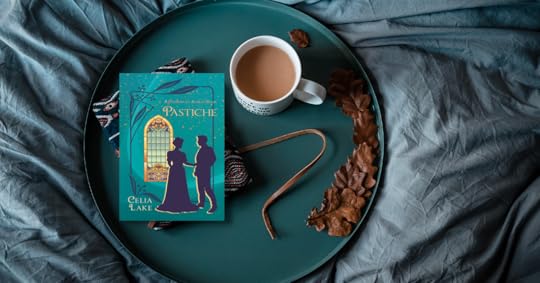 Living well with chronic illness
Living well with chronic illnessAlysoun, the heroine of this book, lives with what we’d call fibromyalgia today. At the time of the book, they don’t quite have a name for it: fibrositis (the earlier name) shows up in the medical literature for the first time late in 1906.
What she knows is that her body aches – often and also unpredictably. She struggles with fatigue and brain fog, wanting to have an engaged and active life, and yet also not wanting to spend her limited time and energy on social events she doesn’t enjoy.
The trick is that she is Lady Alysoun, married to Lord Richard, who not only has those obligations to the land magic, but who is also a member of the Guard (Albion’s equivalent to the police, more on that in the next section), and who is asked to become a magistrate in the course of the book. Being a magistrate comes with a number of additional social obligations for both of them, as well.
My chronic health stuff is not exactly the same as Alysoun’s – though at points in my life, I have had a lot more of all of her main symptoms than I do at the moment (if sometimes in slightly different modes.) Writing that experience, however, comes straight from my desire to have someone like me be loved, have pleasure, and find a place in the world that suits her.
Alysoun’s experiences are also rooted in many conversations I’ve had with a dear friend who shares some of her symptoms too. Specifically, “If I’m going to hurt if I don’t do this thing that would also bring me pleasure, and I’m going to hurt if I do (maybe a bit more), I’d rather have the pleasure, too.” Navigating that, moment to moment, day to day, year to year, is always a trick. Alysoun’s still learning it in Pastiche, but has found a lot more rhythm and balance by the 1920s, and the later books we see her in.
Now, this is Albion, and so there is a touch of fantasy here. Veritas, the Edgarton family home, started as a Roman villa, and the hypocaust system has been tended over many years. She can therefore retreat to a series of baths I absolutely envy, including the deep multi-person hot soaking tub.
The Guard, power, and responsibilityI wrote the draft of Pastiche between November 2019 and February 2020. I was editing it over the summer of 2020, as George Floyd was murdered by police officers in Minneapolis. (I lived in the Twin Cities for more than a decade, my last few not too far from Lake Street and Minnehaha Ave.)
I did a lot of thinking about this particular book, about the history of policing, about the ways any system (and especially those dealing with authority and law enforcement) can be abused and manipulated. I did a lot of talking with my editor, Kiya.
For one thing, while British policing isn’t perfect either, as I did more and more research, I realised that the history of how organised policing developed was rather different. (And in Albion, coordinated law enforcement in various forms became urgently needed following the Pact in 1484 and establishment of additional portals and means of rapid transporation in the next couple of hundred years.)
I also thought about what I’d already established in Albion (Wards of the Roses features Kate Davies, my other character who is a member of the Guard proper, though in that case, very much in an investigative magical role.)
And I looked at what I’d already embedded in both this book in particular, and in the larger world: the idea of magically enforceable oaths. Every magical person in Albion makes one at the age of 12, and various other professions and occupations make them as well. (Pastiche in fact already had the scenes of Richard taking the magistrate’s oath and the effect it has on him.)
Here’s the thing that was already in the draft, but that I expanded far more thoroughly:
The Guard make something that’s equivalent to a chivalric oath, as Richard describes in the book. It isn’t a perfect protection, but it does mean that people who wish to abuse their power tend to fail out of apprenticeship or are redirected into other roles.
And as Richard points out, a lot of their work is more about solving problems, directing people to appropriate help, seeing to the actual physical and magical safety of people in the community. (This last part is particualrly important since people experimenting with magic they don’t fully understand can have a wide range of implications for the safety of those around them.)
It’s a complicated issue, and a complicated role.
Arranged marriage to love matchI first wrote about Richard in Outcrossing and Alysoun and Richard both appear in Wards of the Roses and On The Bias, where it is clear they adore each other and work well in tandem.
But I also knew they’d been basically an arranged marriage, and I wanted to know how they fell in love.
They married knowing of each other (similar family circles) but not knowing each other well. They married more rapidly than they might have due to Richard’s father’s decline in health. And for the first few years, they are cordial and pleasant, but not close.
Richard had been brought up not to be a bother to women (his mother, who is not a pleasant human, had strong opinions about this.) He thinks he’s being polite and considerate, when Alysoun deeply wants more of his time, attention, and preferably affection. It’s only through the events of the book (and a bit of help from those who are wiser in these things) that they figure out how to navigate that.
(When my beta readers got their hands on this one, they left comments of “RICHARD, TALK TO YOUR WIFE” in many places.)
More of the EdgartonsIt turns out I can’t let them go! They have secondary roles in a number of my other books so far (as well as some upcoming works.)
Richard appears briefly at the end of Outcrossing (in his role as Captain of the Guard) as well as in Complementary, when he gives an assignment to Elizabeth Mason. Richard is Kate’s commanding officer during Wards of the Roses (and Alysoun appears at the end.) They’re both present and helpful during the climactic events of On The Bias.
And then there’s Gabe. Their son has his own romance in The Fossil Door, and his parents also make an appearance in the extras associated with that book. (Sign up for my newsletter to get access to those and upcoming extras.)
They’ll also be making an appearance in Ancient Trust (a prequel novella about Geoffrey Carillon inheriting his title, available in the summer of 2022) and Best Foot Forward (out in November 2022) and some of the extras for that. I’m also chewing on a book about Charlotte, their daughter, though I’m not yet sure exactly where that will fall in my upcoming writing plans.
The post Idea to book: Pastiche appeared first on Celia Lake.



